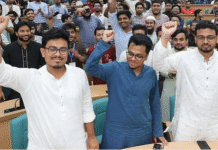
The body of Editor Selina Parvin of Shilalipi at the Rayerbazar killing field discovered right after the Liberation War was over. Photo: File
General Niazi’s strategy of “stretched out fingers rolling back into an iron fist” to hammer the enemy was falling apart as the Indian army and Muktibahini were racing fast towards Dhaka in December, bypassing his army outposts. The Pakistan general was now looking at the horror of defeat as Indian MIGs and Hunters battered Dhaka airport to dysfunction. His much-awaited help from the north (China) and the west (America) did not materialise. So, the Pakistan commander was mostly sulking in his bunker.
It was then that something most sinister was afoot, which actually defined Pakistan’s war on Bangladesh in history in a very unique way. A white microbus smeared with mud and camouflaged with tree branches was moving around the deserted Dhaka streets. Curfew was clamped and so the roads were empty.
Masked young men appeared at the residences of selected intellectuals including teachers, litterateurs, journalists and professionals. Chowdhury Mueen Uddin and Ashrafuzzaman Khan were among the angels of death who whisked away the intel lectuals in the microbus between December 13 and 15. They were in a hurry because everybody knew Dhaka was going to fall anytime. Indian army were already at Amin Bazar, just beyond Mirpur. Paratroopers had landed in Tangail and were advancing. Dhaka was in a pincer grip.
These angels of death belonged to a most dreaded force called Al-Badr, an auxiliary force that the Pakistan army had created in the fashion of Hitler’s most feared SS unit. Drawn from the Jamaat-e-Islami’s student wing Islami Chhatra Sangha, which later turned into Islami Chhatra Shibir, the Al-Badr members were highly indoctrinated with the ideal of saving an Islamic Pakistan at any cost. They were the most ruthless force ever created by the Pakistanis.
The intellectuals were herded into the death camp at Physical Training Institute in Mohammadpur. On the night of December 15, the Al-Badr members came with iron rods, rifles and bayonets. The torture began. The intellectuals were beaten ruthlessly. Their skulls got bashed. Their eyes were gouged out. Their bodies perforated with bayonets.
Then they were dragged to Rayerbazar behind the training institute on the night of December 15 and were one by one finished off.
A day later, the killing field was discovered. The men and women with hands tied behind and blindfolded were lying dead in the bricks, mud and water.
This exposed to the world the most vicious face of Pakistan and its strategy to eliminate the Bangalees. They started the unjust war with genocide, killing innocent, unarmed people. And when they had realised their game was over, they adopted a scorched-earth policy — if we cannot win, we will cripple the Bangalee nation. And the best way to do it was by eliminating their intelligentsia.
The Pakistanis knew if the new nation in waiting could be made devoid of its best children, it would render the country rudderless. That would make the new nation weak and fledgling. The dream for which Bangladesh was created could never come true.
Nothing could be more sinister than some young men like Mueen Uddin and Ashrafuzzaman, both of them journalists at that time, sitting with the Pakistan high-ups and drawing up a hit list with that evil design.
The Times reported on December 23, 1971, that a group of senior Pakistan army officers and their civilian counterparts had met in the city’s Presidential residence. They put together the names of 250 people to be arrested and killed, including the cream of Dhaka’s professional circles not already liquidated.
A diary of Mueen Uddin was later seized that revealed the hit list.
The vengeance with which the Pakistanis executed this plan is unparalleled in history. Scorched-earth policy has been followed since the days war was invented. But even Hitler’s atrocity in Ukraine as the Nazis retreated from Russian attack pales in comparison.
Mishuk Munier, who as a grade seven student last saw his litterateur father Munier Chowdhury being escorted out by the Badr group, remembered this last scene forever. From the balcony of their house, all he could do was to watch that dreadful, unbearable sight of separation and agony. Munier’s body was never found.
Shumon Zahid, son of journalist Selina Parvin, will always hear her mother’s last words: “Shumon, have your lunch. I will come back soon.” Selina’s body, mutilated, was found on December 17.
Today, the two main killers of that gang, Mueen and Ashraf, are sitting in the UK and the USA respectively. The UK could try Mueen under the Geneva Convention signed in 1957. But that did not happen.
But at least some solace could be found in yesterday’s verdict.
Source: The Daily Star









